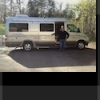
Fortunately, the Kentucky Horse Park campground where we’re staying just off I-75 near Lexington, has a store and it was open, and they had plenty of coffee.
Crisis averted.
I had wanted to boondock on our first night to put the batteries and solar power features of this new motorhome to the test, but since we didn’t arrive here till 8 PM, we decided that because the park has the water turned off during winter and only offers electricity, we’d call this half-boondocking.
I actually thought of just not using the electricity, but since we had to pay $23 for the spot and my wife’s ancestors came from Scotland she said “since we’re paying for it, we’ll use it.”
Later, I saw they had primitive spots here. But we had already paid and settled in.
There were a few others spending the night. I visited with a couple from Ohio headed to Florida for three months in their Type C while getting coffee. But we were pretty much alone in this very large, well maintained campground next to the Kentucky Horse Farm complex which, even in the winter, has several attractions open. We’re decided to save a tour of the barns and a look at the champion blue grass thoroughbreds for another time.
We have an important date tomorrow at noon. We get to have lunch with two of our grandkids at their school in Albany, GA and have to be there by 11:30 AM.
The biggest adjustment in our new motorhome is figuring out what goes where. In a Type B, storage space is at a minimum and we’re going to need a few days and maybe a couple of trips to get it down. I’m seriously thinking about getting a trunk-mounted storage box when we visit the Florida RV Supershow next week.
Tai, our Norwegian Elkhound, immedialy adjusted and loved the long walk we took him on last night in an empty campground.
The temperatures dipped into the upper twenties. The heater in the eTrek, which uses forced air or hot water, is magnificent. We were toasty warm all night and impressed by how quiet it is compared to the previous one.
I have yet to put any water in the eTrek. I should be able to today as the forecast is for unseasonably warm weather, especially as we keep moving south.
It’s time for breakfast, And maybe the horses. Later
Source
- Read more...
- 0 comments
- 1340 views

